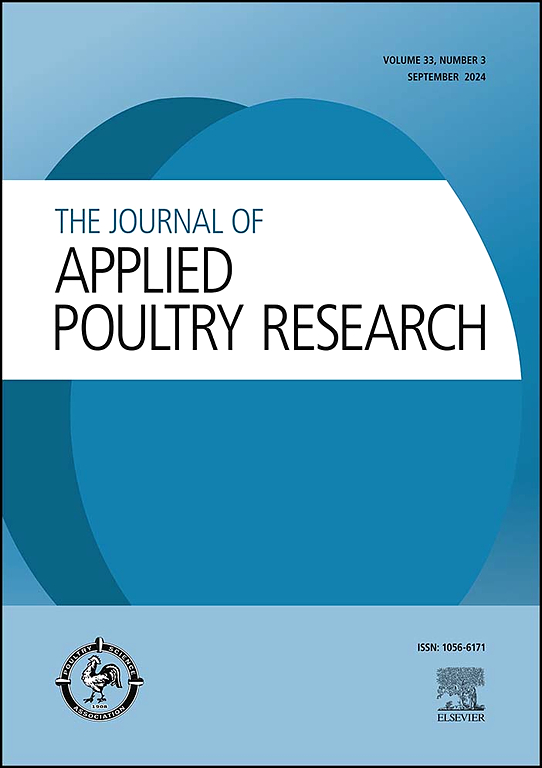Pomegranate peel dietary supplementation in laying hens affects egg yolk color and eggshell quality, decreases yolk lipid oxidation and influences yolk lipidomic profile
IF 1.6
3区 农林科学
Q2 AGRICULTURE, DAIRY & ANIMAL SCIENCE
引用次数: 0
Abstract
Pomegranate peel is a byproduct of the pomegranate juice industry, rich in bioactive compounds. The objective of this study was to evaluate the quality and nutritional parameters of eggs from laying hens fed a diet supplemented with a pomegranate peel byproduct (PPB). A total of 48 Isa Brown laying hens were allotted to four groups (12 replicates per group) and offered the following diets for 8 weeks: Control (0% PPB); PPB1 (1% PPB); PPB2.5 (2.5% PPB); PPB5 (5% PPB). Eggs were collected and analyzed for egg quality parameters, yolk Malondialdehyde (MDA) levels, fatty acid profile, total phenol content, α-tocopherol, cholesterol and lipidomic profile. Sampling was performed weekly, whereas a complete egg quality analysis was performed every two weeks. The results showed that eggshell weight was greater in PPB5 group compared to Control and PPB1 (P=0.008). Eggshell thickness was greater in PPB5 compared to PPB1 (P=0.016). Egg shape index was increased in PPB2.5 treatment (P=0.006). The higher PPB inclusion levels (2.5% and 5%) increased yolk coloration (P=0.014) and reduced yolk MDA content (P<0.001) compared to Control. However, cholesterol content was higher in PPB1 compared to Control (P=0.028). Regarding lipidomic analysis, differentiations in yolk lipid profile were found in PPB2.5 and PPB5 yolks compared to Control (P = 0.022 and P = 0.034 in ESI- and ESI+, respectively). Mainly ceramides were upregulated. Overall, PPB supplementation up to 5% in laying hens can improve several egg quality characteristics and reduce yolk lipid peroxidation.
蛋鸡膳食中补充石榴皮会影响蛋黄颜色和蛋壳质量,降低蛋黄脂质氧化,并影响蛋黄脂质组学特征
石榴皮是石榴汁工业的副产品,富含生物活性化合物。本研究旨在评估蛋鸡饲粮中添加石榴皮副产品(PPB)后所产鸡蛋的质量和营养参数。研究人员将 48 只伊萨-布朗产蛋鸡分为四组(每组 12 个重复),并连续 8 周喂食以下日粮:对照组(0% PPB);石榴皮副产品组(0% PPB);石榴皮副产品组(0% PPB):对照组(0% PPB);PPB1(1% PPB);PPB2.5(2.5% PPB);PPB5(5% PPB)。收集鸡蛋并分析鸡蛋质量参数、蛋黄丙二醛(MDA)水平、脂肪酸概况、总酚含量、α-生育酚、胆固醇和脂质体概况。每周采样一次,每两周进行一次全面的蛋品质量分析。结果显示,与对照组和 PPB1 相比,PPB5 组蛋壳重量更大(P=0.008)。与 PPB1 相比,PPB5 的蛋壳厚度更大(P=0.016)。PPB2.5 处理的蛋形指数增加(P=0.006)。与对照组相比,较高的 PPB 添加量(2.5% 和 5%)增加了蛋黄着色(P=0.014),降低了蛋黄 MDA 含量(P<0.001)。然而,与对照组相比,PPB1 的胆固醇含量更高(P=0.028)。在脂质体分析方面,与对照组相比,PPB2.5 和 PPB5 蛋黄的脂质谱出现了差异(在 ESI- 和 ESI+ 中分别为 P = 0.022 和 P = 0.034)。上调的主要是神经酰胺。总之,在蛋鸡中添加最高达 5%的 PPB 可改善多种鸡蛋质量特性并降低蛋黄脂质过氧化。
本文章由计算机程序翻译,如有差异,请以英文原文为准。
求助全文
约1分钟内获得全文
求助全文
来源期刊

Journal of Applied Poultry Research
农林科学-奶制品与动物科学
CiteScore
4.10
自引率
10.50%
发文量
80
审稿时长
104 days
期刊介绍:
The Journal of Applied Poultry Research (JAPR) publishes original research reports, field reports, and reviews on breeding, hatching, health and disease, layer management, meat bird processing and products, meat bird management, microbiology, food safety, nutrition, environment, sanitation, welfare, and economics. As of January 2020, JAPR will become an Open Access journal with no subscription charges, meaning authors who publish here can make their research immediately, permanently, and freely accessible worldwide while retaining copyright to their work. Papers submitted for publication after October 1, 2019 will be published as Open Access papers.
The readers of JAPR are in education, extension, industry, and government, including research, teaching, administration, veterinary medicine, management, production, quality assurance, product development, and technical services. Nutritionists, breeder flock supervisors, production managers, microbiologists, laboratory personnel, food safety and sanitation managers, poultry processing managers, feed manufacturers, and egg producers use JAPR to keep up with current applied poultry research.
 求助内容:
求助内容: 应助结果提醒方式:
应助结果提醒方式:


